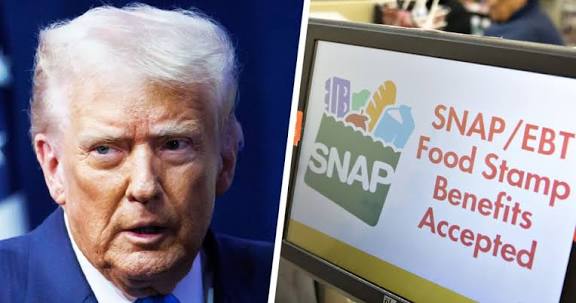NEWS
Trump’s Hardline SNAP Cuts Hit Republican States the Hardest — Data Shows Red States Rely More on Food Assistance Than Blue States

As Donald Trump and his allies push a hardline stance on food assistance, millions of Americans — especially those in Republican-leaning states — are the ones standing to lose the most. It’s a bitter irony that the regions waving the red flag of loyalty to Trump are also the ones most dependent on the very SNAP benefits his policies threaten to cut.
According to recent USDA and Census data, states like Mississippi, Louisiana, West Virginia, and Alabama — all Republican strongholds — have the highest percentages of residents relying on food stamps, ranging between 14% and 17% of their populations. These are communities already grappling with lower wages, limited job opportunities, and chronic poverty — realities that make SNAP not a luxury, but a lifeline.
Meanwhile, Democratic states such as California, New York, and Massachusetts, though larger in population, have lower SNAP participation rates, averaging around 8–11%. They contribute more to the federal pool that funds SNAP, yet their residents depend less on it proportionally.
Trump’s proposed restrictions — from tighter work requirements to reduced federal funding — would therefore strike hardest in the rural South and Midwest, where economic vulnerability runs deep and local safety nets are thin. Cutting SNAP in these areas isn’t just a fiscal decision — it’s an assault on the same working-class families who form the backbone of his political base.
As one policy expert put it, “The paradox is glaring: Trump’s war on food assistance is a war on his own voters.”
At a time when 43 million Americans depend on SNAP to keep food on the table, Trump’s political theater of “tough love” risks pushing Red America further into hunger and hardship — proving that ideology, not empathy, is driving policy.
Overall Trend
Republican-leaning (red) states generally depend more on SNAP benefits than Democrat-leaning (blue) states — when measured by percentage of population receiving SNAP rather than total number of recipients.
Breakdown:
Southern and rural states, which tend to vote Republican, have higher SNAP participation rates because of higher poverty levels, lower wages, and fewer urban job opportunities.
Blue states like California and New York have more total recipients (due to population size), but lower percentages of residents relying on SNAP relative to population.
Examples — Republican-Leaning, High Dependence:
State % of Population on SNAP Political Lean
Mississippi ~17% Republican
Louisiana ~16% Republican
West Virginia ~15% Republican
Alabama ~14% Republican
Oklahoma ~13% Republican
Examples — Democrat-Leaning, Lower Dependence:
State % of Population on SNAP Political Lean
California ~10% Democrat
New York ~11% Democrat
Massachusetts ~9% Democrat
Washington ~8% Democrat
Illinois ~10% Democrat
In Summary:
Red states rely more on SNAP benefits per capita.
Blue states fund more SNAP spending overall, since they have more people and higher costs of living.
Ironically, many conservative states that oppose SNAP expansions are also the ones where citizens depend on it most.











